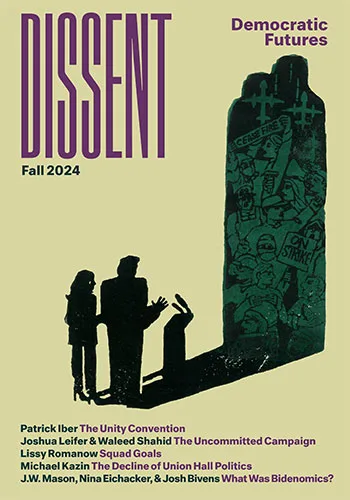What Happened to Earth Day?
What Happened to Earth Day?
In 1970, as many as twenty million Americans took part in the first Earth Day. A cluster of young activists, inspired by liberal Senator Gaylord Nelson, put together what is still the largest demonstration in the nation’s history. Protesters listened to Pete Seeger down by the Washington Monument, rode horses down a busy highway, and dumped oil into an elegant pool outside the headquarters of Standard Oil—among thousands of other gatherings and antics. Surely, none of the organizers could have imagined that today, exactly forty-three years later, their successors would be green with envy at the political clout of the NRA.
Why has the contemporary environmental movement been unable to inspire millions of Americans to pressure Congress to take effective steps to stall or roll back climate change? Some grassroots activists blame lobbyists for groups like the Sierra Club and the National Resources Defense Council for devoting their time and energy to failed attempts at Capitol deal-making rather than to agitating, broadly and intelligently, for the cause. Others point to the attack on “climatism” by such prominent conservatives as George Will and Rush Limbaugh who deny there is any problem at all—and whose views are echoed by most Republicans in Congress, as well as supported by funding from the Koch brothers and their ilk. Some fault Obama for putting little time or political muscle behind his lofty promise, in 2008, that, if elected president, “the rise of the oceans” would begin “to slow” and the planet would begin “to heal.” Others just sigh that, at a time of economic distress for many and uncertainty for all, saving the earth is not a priority for those who aren’t already committed to it.
Two years ago, Bradford Plumer summarized this internal debate in the New Republic. Not much has changed since then. However, the most salient reason for the waning of the greens may be rather simple: American voters do not view climate change, unlike issues on which environmentalists won in the past, as an immediate threat to either their health or their wealth. Hurricanes may be stronger, summers hotter, and droughts longer than ever. But unless you’re a climate scientist or follow their research closely, it’s difficult to know for sure whether these phenomena signal the beginning of a historic calamity or are merely events on a cyclical pattern. At any rate, supermarkets offer an ever increasing variety of foods at fairly stable prices, while Mardi Gras was celebrated on schedule in New Orleans not long after Katrina blew through. Most coverage of climate change traffics heavily in words like “could” and “potentially.” It’s hard to build a world-saving movement on that.
The first Earth Day, by contrast, was the culmination of more than a decade of rising alarm and activism about environmental damage or “pollution” that had already occurred. As described in two fine new books, by historians Adam Rome and Christopher Sellers—The Genius of Earth Day (Hill and Wang, 2013) and Crabgrass Crucible (UNC Press, 2013)—these outrages included fallout from nuclear testing in Nevada and overseas, DDT in the growing suburbs, an oil spill just off the coast from gorgeous Santa Barbara, choking smog in the Los Angeles basin, and a massive oil slick burning on the Cuyahoga River in Cleveland (cue the classic Randy Newman song). In the 1970s, the discovery of toxic wastes in the Niagara Falls neighborhood of Love Canal and the near meltdown at the Three Mile Island Nuclear Plant in Pennsylvania just added to the public’s anxiety. All over the country, Americans wondered where the man-made befouling demons would strike next.
At the time, environmentalist fervor was even strong enough to inspire urgent protests about a problem as comparatively benign as “urban sprawl.” In 1966, Margo Tupper wrote about the bulldozers, which invaded her suburb outside Washington, D.C.:
These huge earth-eating machines raped the woods, filled up the creek, buried the wildflowers and frightened away the rabbits and birds. In less than a month, the first of two hundred look-alike, closely set small houses rose to take the place of our beautiful forest.
In response, a growing movement allied with the still sizeable and bipartisan cohort of liberals in Congress and state legislatures succeeded in enacting measures that ameliorated many of these problems. Air quality in Los Angeles and other big cities did improve, the EPA (established just seven months after the first Earth Day) set up Superfund sites to quarantine hazardous wastes, and plans to build new nuclear plants were abandoned. Gradually, Americans also got used to recycling their garbage and finding ways to use energy more efficiently. These changes, however partial, made it seem as if the authorities, with backing from an aroused and responsible public, were addressing the problems they helped create. With nudging from the conservative, property-rights insurgency, many Americans began wondering whether they still needed an environmental movement.
To show that they do, activists will have to go on the offensive again. They might begin by learning from the very gun lobby they detest. The NRA and the arms manufacturers who fund it are expert at defining and raising hell about threats, real or imagined, to the holy writ of the Second Amendment. Then they know exactly how to mobilize ferociously to defeat their enemies—while never believing that the war is over.
But the sad truth is that it may take a horrific disaster—perhaps a cyclone-caused flood that kills tens of thousands of coast-dwellers somewhere in the world—to spark the kind of outrage and action once provided by smog days and plumes of radioactive discharge. Meanwhile, before it’s too late, anyone who understands the mounting peril can only keep stressing that the problem is both local and global—and marshal the reason and the passion to solve it.
Michael Kazin is the editor of Dissent.
Cross-posted from the New Republic.




